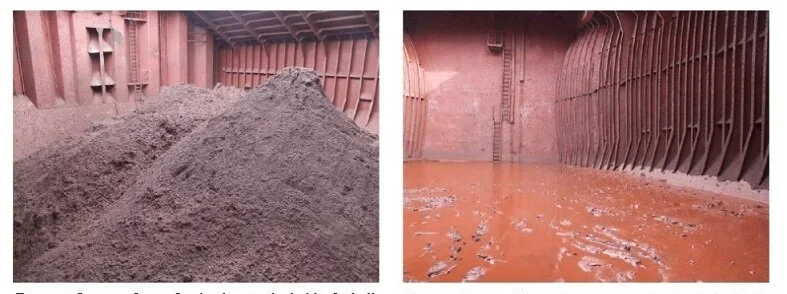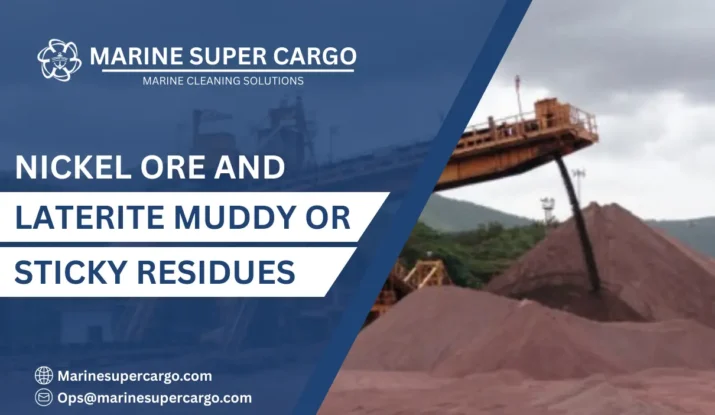Nickel ore and laterite muddy or sticky residues present exceptional challenges in bulk carrier operations worldwide. These adhesive materials create persistent contamination that bonds strongly to cargo hold surfaces, requiring specialized removal techniques. Understanding the complex nature of nickel ore and laterite muddy or sticky residues is essential for maintaining vessel cleanliness and ensuring successful cargo transitions.
The transportation of nickel ore and laterite generates clay-like deposits that adhere tenaciously to bulkheads, tank tops, and structural components throughout cargo spaces. Nickel ore and laterite muddy or sticky residues create cleaning complexities that extend far beyond conventional dry bulk cargo residues. These materials form plastic-like coatings when exposed to moisture during transport operations.
Nickel ore and laterite muddy or sticky residues affect all areas of bulk carriers, from bow to stern compartments. The high clay content creates adhesive properties that resist standard cleaning methods. Port and starboard holds experience varying contamination levels based on moisture exposure and cargo settling patterns during voyage operations.
Understanding Nickel Ore and Laterite Contamination Patterns
Nickel ore and laterite muddy or sticky residues exhibit unique physical properties that complicate standard cleaning procedures. The high clay and iron content creates plastic-like consistency when wet, while forming hard, concrete-like deposits when dried. These materials penetrate deep into structural joints and coating imperfections.
Moisture interaction with nickel ore and laterite muddy or sticky residues creates expansive clay formations that fill cargo hold recesses and ventilation openings. These deposits bond chemically with steel surfaces, creating permanent adhesion if not promptly removed. Forward holds near the forecastle often experience more severe contamination due to condensation patterns.
The colloidal nature of laterite particles allows deep penetration into porous surfaces and protective coating systems. Nickel ore and laterite muddy or sticky residues create environments where conventional water washing proves inadequate for complete removal. Professional assessment determines appropriate mechanical and chemical cleaning approaches.

MARPOL and IMO Environmental Compliance Framework
The International Maritime Organization (IMO) establishes comprehensive guidelines for managing mineral cargo residues and environmental protection requirements. MARPOL Annex V specifically addresses waste management protocols for nickel ore and laterite muddy or sticky residues cleaning operations.
Nickel ore and laterite muddy or sticky residues cleaning must comply with international environmental standards for heavy metal waste disposal. All cleaning residues containing nickel compounds require proper containment and certified disposal methods. The IMO mandates detailed documentation of cleaning procedures and waste handling protocols.
Environmental protection regulations under MARPOL require careful management of cleaning wastewater containing mineral residues. Vessel operators must ensure compliance with discharge regulations while maintaining accurate records of all activities involving nickel ore and laterite muddy or sticky residues.
Professional Cleaning Solutions by Marine Super Cargo
Marine Super Cargo specializes in addressing nickel ore and laterite muddy or sticky residues through advanced cleaning methodologies specifically developed for adhesive mineral deposits. Our experienced teams understand the unique challenges posed by lateritic materials and employ proven removal techniques.
Our comprehensive approach includes systematic assessment of adhesion patterns throughout cargo spaces. We utilize high-pressure water systems combined with specialized chemical agents designed for breaking down clay-based deposits. Nickel ore and laterite muddy or sticky residues removal requires careful coordination between mechanical and chemical cleaning phases.
Marine Super Cargo employs specialized scraping equipment designed to remove stubborn deposits without damaging underlying protective coatings. Our teams work methodically through vessel spaces from tank tops to bilge areas, ensuring complete removal of all nickel ore and laterite muddy or sticky residues from accessible surfaces.
Technical Challenges and Specialized Solutions
Bulk carriers face multiple complications when dealing with nickel ore and laterite muddy or sticky residues. Adhesive deposits resist conventional cleaning methods, requiring mechanical intervention that risks coating damage. The plastic consistency of wet residues allows deep penetration into structural joints and equipment housings.
Port-side and starboard holds often display different deposit patterns due to vessel movement and moisture migration during transport. Aft sections near the stern may experience concentrated contamination in areas with restricted drainage. Forward holds require particular attention to remove deposits that accumulate in structural recesses and ventilation systems.
Prevention and Risk Management Strategies
Preventing excessive nickel ore and laterite muddy or sticky residues formation begins with proper cargo handling and moisture control procedures. Ensuring adequate drainage systems minimizes water accumulation that creates adhesive conditions. Regular monitoring during cargo operations enables early intervention when contamination levels increase.
Crew training plays a crucial role in managing laterite cargoes effectively. Understanding the behavior of nickel ore and laterite muddy or sticky residues helps crews implement appropriate protective measures during loading and discharge operations. Proper equipment maintenance prevents residue accumulation in mechanical systems.
Marine Super Cargo provides comprehensive prevention programs designed to minimize contamination risks. Our services include drainage system maintenance, moisture control protocols, and crew training programs focused on laterite cargo handling best practices.
Industry Standards and Best Practices
Maritime industry standards for handling nickel ore and laterite muddy or sticky residues continue evolving with improved cleaning technologies and protective coating systems. Modern bulk carriers incorporate enhanced drainage designs and specialized coating formulations. These innovations help reduce cleaning requirements and improve operational efficiency.
Cleaning protocols must balance thorough contamination removal with coating preservation requirements. Proper technique selection ensures complete nickel ore and laterite muddy or sticky residues removal while maintaining protective system integrity. Quality control measures verify cleaning effectiveness before cargo hold certification.
International mineral cargo handling standards require coordination between ship operators, cleaning contractors, and classification societies. Marine Super Cargo facilitates this coordination through comprehensive service packages that ensure regulatory compliance and operational excellence.
Environmental and Safety Considerations
Modern cleaning approaches for nickel ore and laterite muddy or sticky residues emphasize environmental responsibility and worker safety. Proper containment systems prevent contaminated wastewater discharge while ensuring effective residue removal. Personal protective equipment protects personnel from mineral dust exposure during cleaning operations.
Waste treatment protocols ensure proper handling of cleaning residues containing heavy metals. These approaches align with MARPOL environmental protection objectives while maintaining operational safety standards throughout nickel ore and laterite muddy or sticky residues removal operations.
Frequently Asked Questions
Q1: What makes laterite residues more difficult to clean than other mineral cargoes?
A: Laterite contains high clay content that creates adhesive, plastic-like consistency when wet, forming strong bonds with steel surfaces that resist conventional cleaning methods.
Q2: What cleaning techniques effectively remove sticky nickel ore deposits?
A: Combination of mechanical scraping, high-pressure water washing, and specialized chemical agents designed to break down clay-based adhesive properties are most effective.
Q3: How long does complete removal of laterite residues typically require?
A: Complete cleaning varies by contamination severity, typically requiring 48-96 hours including mechanical removal, chemical treatment, and thorough rinsing phases.
Q4: What MARPOL requirements apply to nickel ore cleaning waste disposal?
A: All cleaning residues containing heavy metals must be collected and disposed of at certified hazardous waste facilities with proper documentation according to environmental regulations.
Q5: Can sticky laterite deposits damage cargo hold protective coatings?
A: Yes, strong adhesion can damage coatings during removal if improper techniques are used, making professional cleaning essential to preserve protective systems.
For professional bulk carrier hold cleaning services specializing in adhesive mineral cargo residues, contact Marine Super Cargo today. Our expert teams ensure complete contamination removal while maintaining MARPOL compliance and coating system integrity.


